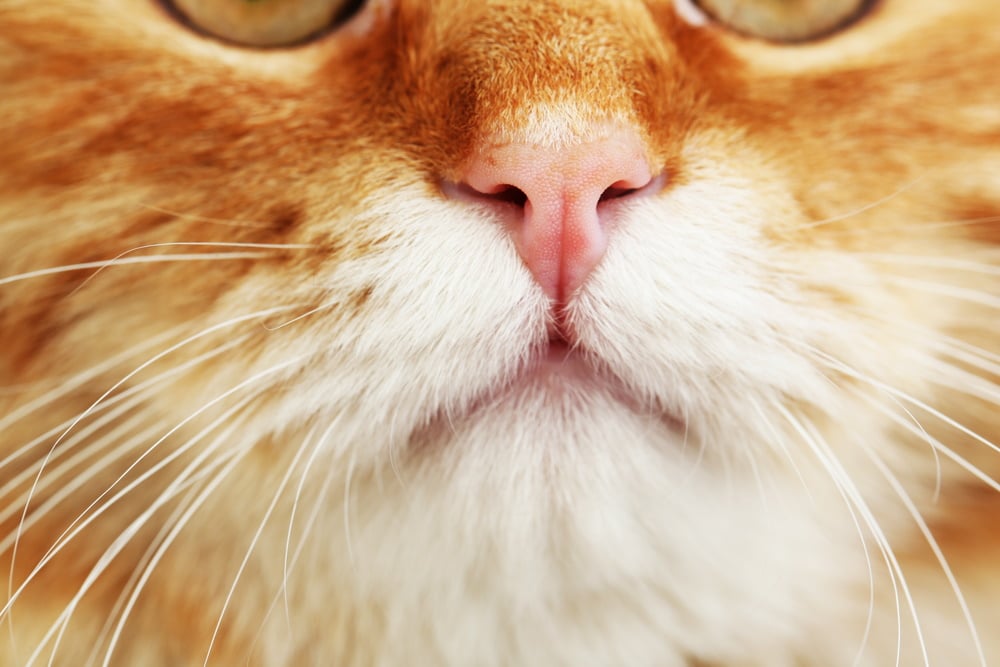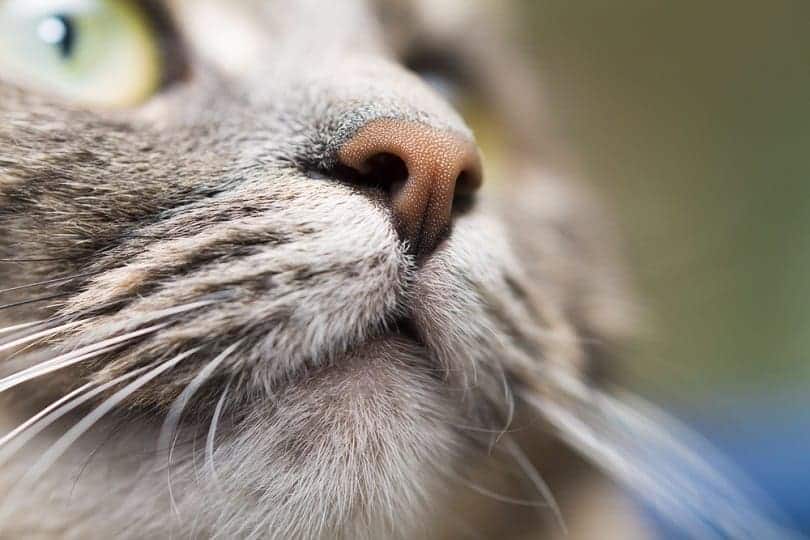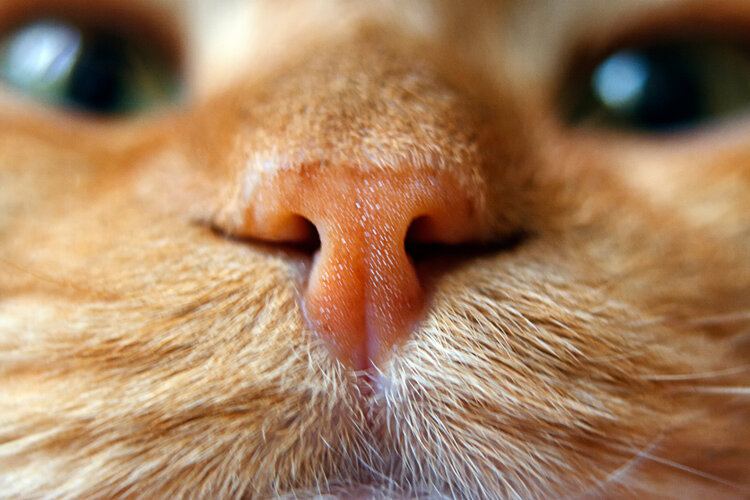Click to Skip Ahead
A cat’s nose can occasionally be used as a reasonable indication of their health, but this can be quite variable and should not be fully relied upon. It depends a lot on outside environmental conditions, as well as the cat themselves.
A cat’s nose is usually wet from the clear and barely noticeable mucus produced in the nasal cavity in order to trap scent molecules and enhance their senses. It may also have a limited role when it comes to regulating their body temperature through evaporation, although the majority of sweat glands that cats have are located on their paws and face.
While it was previously believed that a wet nose might be considered healthy or normal and a dry nose more of a cause for concern, it’s a little bit more complicated than that. A wet nose with discharge is often a sign of health issues affecting the upper respiratory tract or the mouth. You shouldn’t jump to conclusions and assume that your cat is unwell if they do have a dry nose, though.
Are Cats Supposed to Have a Wet Nose?
If your cat headbutts you or rubs their nose against your hand while you’re petting them, you may have noticed that they have a wet nose. This doesn’t mean that they have a cold, nor is it a sign that they are necessarily healthy.
In fact, a cat’s nose is usually wet because of a clear and often unnoticeable mucus production. One incredible thing about a cat’s wet nose is that it actually helps improve their sense of smell. The feline sense of smell is already incredibly delicate, but the dampness of their nose traps scent molecules, which gives the cat a more successful way to sniff and identify a smell.
It is important to protect your cat’s nose. They have around 45 to 80 million scent receptors, up to 200 million at best, which is more than people but less than dogs.1 This does not mean they cannot discern between smells. On the contrary, they will sometimes outperform dogs as well.2
Cats, like many other mammals, have an additional organ that helps them pick up even more subtle odorless chemicals, like pheromones, called a Jacobson or vomeronasal organ. This organ is located in the nasal cavity, extending and opening through the roof of the mouth just behind the upper incisors. Cats will usually have a peculiar disgusted facial expression with a slightly opened mouth while curling their lips when they are utilizing their Jacobson organ.
Cats can use smell to identify a potential mate or a female in heat, identify and track prey, and identify another cat encroaching on their territory. Also, no two cat noses are alike; they are as unique as human fingerprints.
Cats cannot sweat from the whole of their body as people can. Their nose, along with the pads of their feet, may be one of the few places to allow evaporation. This is why cats leave damp footprints in the summer. They get hot, and to self-regulate temperature, they sweat from their paws. Some of the dampness may also come from your cat’s tear ducts.

Reasons Your Cat Might Have a Dry Nose
There are some occasions when your cat’s nose might feel dry and warm. This doesn’t necessarily mean that they’re ill, but it does warrant further investigation.
Cats love dry and warm spots. They especially like laying in sunspots, on top of heaters, and high up in naturally warm spots. If your cat was on the radiator, there is a good chance that it is the cause of their nose being dry, and it will dampen again soon. Some cats simply have drier noses than others, so your kitty may be one of the ones with a rough-feeling dry nose.
It is worth noting, however, that cats are not the best water drinkers. Some get the moisture that they require from food and other sources, and others struggle with the concept of drinking sufficient amounts from a water bowl. In these cases, your cat’s nose may be a little bit more dry than usual. Ensure that your cat drinks water and gets enough fluid every day. Not all dehydrated or sick cats will have a dry nose.
On the other hand, if your cat had just had a drink, was eating and licked their lips, or has been grooming themselves, their nose may be wet. The moisture appearance of the nose greatly depends on the outside environment, like temperature, precipitation, and humidity, but also the action the cat was just performing when you assessed their nose.

When You Should Be Concerned
There are a few occasions when a dry or, more commonly, a particularly wet cat nose is worrisome. Look for additional signs, such as runny eyes, discharge from the nose, snuffling, sneezing, or a loss of appetite. You know your cat and their typical behavior better than anybody else, so are they acting out of character?
Such signs could mean that your cat has a respiratory infection. These are similar to colds and, in some cases, may disappear within a week. However, multiple, persistent, or worsening signs are more troubling and always warrant veterinary consultation.
Sunburn is a potential cause of a dry nose. Cats have no fur on their noses, so they are quite exposed to the sun’s hot rays, especially if your cat is a sun worshiper. This is especially a problem with white cats, and their ears are at a particular risk of sun damage. Apply feline-appropriate and vet-approved sunscreen, close the blinds where your cat usually chooses to sit, and keep your cat out of the hottest rooms during peak sun hours to avoid sunburned noses.
A cat with a fever that isn’t feeling well, for whatever reason, may easily have a dry nose. If your cat is behaving normally and eating, this is probably just the normal level of dryness or wetness of their nose. But if they are lethargic, slow, put off their food, or showing any other changes in their behavior, appetite, drinking, or toileting habits, they should see a veterinarian as soon as possible.
Conclusion – Why Are Cats Noses Wet?
Cats usually have wet noses because they produce a clear mucus that lines the nasal cavity and traps scent molecules. It may also help to regulate their body temperature through evaporation and rapid breathing, but be mindful that this is often a sign of overheating and is a genuine medical emergency.
A wet nose on its own without any signs of illness is not usually a cause for concern (the same applies for a dry nose). Your cat may have actually licked the normal mucus secretion from their nose, or they may have dried it out by sitting too close to the radiator.
On the other hand, both a wet and dry nose could be indicative of illness, particularly if your cat is lethargic, not eating, is snuffly, or has a nasal or ocular discharge, all of which require veterinary attention.
Featured Image Credit: Annashou, Shutterstock










